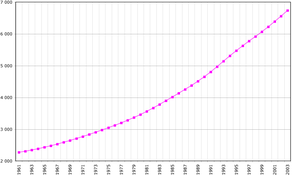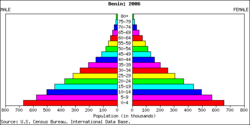Demographics of Benin
2007 Schools Wikipedia Selection. Related subjects: African Geography
The majority of Benin’s 6.59 million people live in the south. The population is young, with a life expectancy of 50 years.
About 42 African ethnic groups live in this country; these various groups settled in Benin at different times and also migrated within the country. Ethnic groups include:
- the Yoruba in the southeast (migrated from Nigeria in the 12th century);
- the Dendi in the north-central area (they came from Mali in the 16th century);
- the Bariba and the Fulbe (Peul) in the northeast;
- the Betammaribe and the Somba in the Atacora Range;
- the Fon in the area around Abomey in the South Central; and
- the Mina, Xueda, and Aja (who came from Togo) on the coast.
French is the official language but is spoken more in urban than in rural areas. The literacy rate is 52.2% adult males and 23.6% adult females, and slowly growing. Recent migrations have brought other African Nationals to Benin: Nigerians, Togolese, Malians, etc. The foreign community also includes many Lebanese and Indians involved in trade and commerce. The personnel of the many European Embassies and Foreign Aid Missions and of nongovernmental organizations and various missionary groups account for a large number of the 5,500 European population.
Several religions are practiced in Benin. Animism is widespread (50%), and its practices vary from one ethnic group to the other. Arab merchants introduced Islam in the north and among the Yoruba. European missionaries brought Christianity to the south and central areas of Benin. Muslims account for 20% of the population and Christians for 30%. Many nominal Muslims and Christians continue to practice animistic traditions. It is believed that voodoo originated in Benin and was introduced to Brazil and the Caribbean Islands by slaves taken from this particular area of the Slave Coast.
Demographic data from the CIA World Factbook
Population
- 7,862,944
- Note: estimates for this country explicitly take into account the effects of excess mortality due to AIDS; this can result in lower life expectancy, higher infant mortality and death rates, lower population and growth rates, and changes in the distribution of population by age and sex than would otherwise be expected (July 2006 est.)
Age structure
- 0-14 years: 44.1% (male 1,751,709/female 1,719,138)
- 15-64 years: 53.5% (male 2,067,248/female 2,138,957)
- 65 years and over: 2.4% (male 75,694/female 110,198) (2006 est.)
- 15-64 years: 53.5% (male 2,067,248/female 2,138,957)
Population growth rate
- 2.73% (2006 est.)
Birth rate
- 38.85 births/1,000 population (2006 est.)
Death rate
- 12.22 deaths/1,000 population (2006 est.)
Net migration rate
- 0.67 migrant(s)/1,000 population (2006 est.)
Sex ratio
- At birth: 1.03 male(s)/female
- Under 15 years: 1.02 male(s)/female
- 15-64 years: 0.97 male(s)/female
- 65 years and over: 0.69 male(s)/female
- Total population: 0.98 male(s)/female (2006 est.)
- Under 15 years: 1.02 male(s)/female
Infant mortality rate
- Total: 79.56 deaths/1,000 live births
- Male: 84.09 deaths/1,000 live births
- Female: 74.88 deaths/1,000 live births (2006 est.)
- Male: 84.09 deaths/1,000 live births
Life expectancy at birth
- Total population: 53.04 years
- Male: 51.9 years
- Female: 54.22 years (2006 est.)
- Male: 51.9 years
Total fertility rate
- 5.2 children born/woman (2006 est.)
HIV/AIDS
- Adult prevalence rate: 1.9% (2003 est.)
- People living with HIV/AIDS: 68,000 (2003 est.)
- Deaths: 5,800 (2003 est.)
- People living with HIV/AIDS: 68,000 (2003 est.)
Major infectious diseases
- Degree of risk: very high
- Food or waterborne diseases: bacterial and protozoal diarrhea, hepatitis A, and typhoid fever
- Vectorborne diseases: malaria, yellow fever, and others are high risks in some locations
- Respiratory disease: meningococcal meningitis (2005)
- Food or waterborne diseases: bacterial and protozoal diarrhea, hepatitis A, and typhoid fever
Nationality
- Noun: Beninese (singular and plural)
- Adjective: Beninese
Ethnic groups
- African 99% (42 ethnic groups, most important being Fon, Adja, Yoruba, Bariba), Europeans 10,000
Religions
- Indigenous beliefs 50%, Christian 30%, Muslim 20%
Languages
- French (official), Fon and Yoruba (most common vernaculars in south), tribal languages (at least six major ones in north)
Literacy
- Definition: age 15 and over can read and write
- Total population: 33.6%
- Male: 46.4%
- Female: 22.6% (2002 est.)
- Total population: 33.6%

